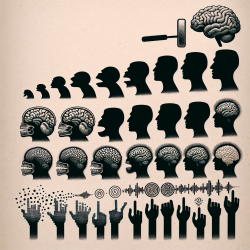Introduction
In the realm of speech-language pathology, understanding the evolution of the human brain can provide valuable insights into the development of speech and language capabilities. The research article "Interpreting Sulci on Hominin Endocasts: Old Hypotheses and New Findings" by Dean Falk offers a detailed examination of sulcal patterns on hominin endocasts. These patterns provide crucial information about the evolution of the cerebral cortex and cognition in human ancestors. This blog will explore how practitioners can enhance their skills by integrating the findings of this research or by pursuing further studies in this area.
The Significance of Sulcal Patterns
Sulcal patterns, the grooves on the surface of the brain, are vital in understanding the reorganization of the cerebral cortex during hominin evolution. Falk's research highlights three key regions where sulcal patterns have evolved: the parietotemporo-occipital association cortex, Broca's speech area, and the dorsolateral prefrontal association cortex. Of these, the evidence regarding the dorsolateral prefrontal cortex is the clearest, showing a middle frontal sulcus in Australopithecus endocasts that is derived toward the human condition.
Implications for Speech-Language Pathology
For practitioners in speech-language pathology, these findings underscore the importance of understanding the brain's structural evolution in relation to speech and language development. Broca's area, associated with speech production, shows significant evolutionary changes that can inform therapeutic approaches. By examining the comparative cytoarchitecture of ape and human brains, practitioners can gain insights into the neurological underpinnings of speech and language disorders.
Encouraging Further Research
While the current research provides a foundation, there is a need for further comparative cytoarchitectonic studies, particularly focusing on Brodmann's areas 44, 45, and 47. These studies could enhance our understanding of the evolutionary pathways that led to the development of human speech and language capabilities. Practitioners are encouraged to engage with this research, either by incorporating its findings into their practice or by contributing to ongoing studies.
Conclusion
The study of sulcal patterns on hominin endocasts offers valuable insights into the evolution of the human brain and its implications for speech-language pathology. By integrating these findings into practice and pursuing further research, practitioners can contribute to improved outcomes for children with speech and language disorders. To delve deeper into the original research, please follow this link: Interpreting sulci on hominin endocasts: old hypotheses and new findings.










